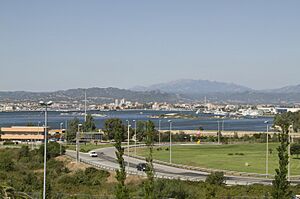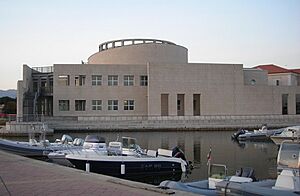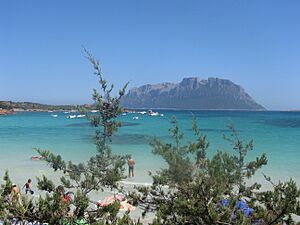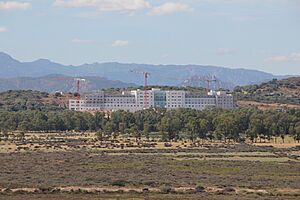Olbia facts for kids
Quick facts for kids
Olbia
|
||
|---|---|---|
| Comune di Olbia | ||
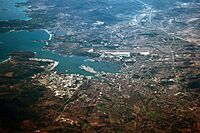
November 2014 aerial photograph of Olbia. The airport and the harbour are both visible.
|
||
|
||
| Country | Italy | |
| Region | Sardinia | |
| Province | Sassari | |
| Frazioni | Berchiddeddu, Murta Maria, Pittulongu, Rudalza-Porto Rotondo, San Pantaleo | |
| Area | ||
| • Total | 383.64 km2 (148.12 sq mi) | |
| Population
(30 May 2018)
|
||
| • Total | 60,345 | |
| • Density | 157.296/km2 (407.395/sq mi) | |
| Demonym(s) | Olbiesi | |
| Time zone | UTC+1 (CET) | |
| • Summer (DST) | UTC+2 (CEST) | |
| Postal code |
07026
|
|
| Dialing code | 0789 | |
| Patron saint | St. Simplicius | |
| Saint day | May 15 | |
Olbia is a city in northeastern Sardinia, Italy. It is home to over 60,000 people. The city is located in the historical region of Gallura.
Olbia has had different names throughout history. In Roman times, it was called Olbia. During the Middle Ages, it was known as Civita. Later, until the 1940s, its name was Terranova Pausania. Today, it is officially called Olbia again.
Contents
History of Olbia
The name Olbia comes from Greek, but the city was first settled by the ancient Nuragics or Phoenicians. This is what archaeologists have found. Olbia has many old ruins from different times. These include buildings from the Nuragic era and the Roman era. It was a very important port during Roman times.
In the Middle Ages, Olbia was the capital of the Giudicato of Gallura. This was one of the four independent states in Sardinia. During the First Punic War, the Romans fought against the Carthaginians and Sardinians near Olbia.
Geography of Olbia
Olbia is a major economic center for this part of Sardinia. It has many commercial centers and food industries. The city is also very close to the famous Costa Smeralda tourist area.
Olbia is a popular place for tourists. People visit for its beautiful sea and beaches. There are also many interesting cultural sites to explore.
Olbia's Climate
Olbia has a Mediterranean climate. This means it has mild winters. The springs and autumns are warm. Summers in Olbia are hot.
| Climate data for Olbia, Sardinia | |||||||||||||
|---|---|---|---|---|---|---|---|---|---|---|---|---|---|
| Month | Jan | Feb | Mar | Apr | May | Jun | Jul | Aug | Sep | Oct | Nov | Dec | Year |
| Record high °C (°F) | 25.1 (77.2) |
24.5 (76.1) |
28.0 (82.4) |
27.8 (82.0) |
35.0 (95.0) |
39.9 (103.8) |
47.4 (117.3) |
41.0 (105.8) |
38.3 (100.9) |
33.3 (91.9) |
29.0 (84.2) |
24.0 (75.2) |
47.4 (117.3) |
| Mean daily maximum °C (°F) | 14.6 (58.3) |
15.2 (59.4) |
16.5 (61.7) |
18.4 (65.1) |
22.7 (72.9) |
27.6 (81.7) |
30.5 (86.9) |
30.8 (87.4) |
27.0 (80.6) |
22.2 (72.0) |
17.8 (64.0) |
15.4 (59.7) |
21.6 (70.8) |
| Mean daily minimum °C (°F) | 5.2 (41.4) |
5.9 (42.6) |
6.3 (43.3) |
8.2 (46.8) |
11.3 (52.3) |
15.4 (59.7) |
18.3 (64.9) |
18.5 (65.3) |
15.9 (60.6) |
11.8 (53.2) |
8.0 (46.4) |
6.1 (43.0) |
10.9 (51.6) |
| Record low °C (°F) | −3.6 (25.5) |
−3.0 (26.6) |
−2.5 (27.5) |
−1.0 (30.2) |
3.9 (39.0) |
7.0 (44.6) |
12.0 (53.6) |
10.0 (50.0) |
8.9 (48.0) |
4.0 (39.2) |
−1.4 (29.5) |
−4.2 (24.4) |
−4.2 (24.4) |
| Average precipitation mm (inches) | 47.3 (1.86) |
72.6 (2.86) |
63.4 (2.50) |
56.1 (2.21) |
37.4 (1.47) |
18.4 (0.72) |
6.4 (0.25) |
28.1 (1.11) |
40.8 (1.61) |
58.4 (2.30) |
55.6 (2.19) |
97.9 (3.85) |
582.4 (22.93) |
| Average precipitation days | 7 | 8 | 8 | 8 | 4 | 3 | 1 | 3 | 5 | 5 | 6 | 9 | 67 |
| Average relative humidity (%) | 70 | 69 | 65 | 66 | 66 | 58 | 60 | 63 | 67 | 65 | 72 | 72 | 66 |
| Mean monthly sunshine hours | 127 | 138 | 186 | 213 | 279 | 312 | 360 | 316 | 249 | 195 | 138 | 118 | 2,631 |
| Source: Aeronautica Militare | |||||||||||||
Main Sights to See
Olbia has many interesting places to visit. Here are some of them:
- The Romanesque former cathedral of San Simplicio. This church was built in the 11th–12th century.
- The Church of St. Paul Apostle, which is a medieval church.
- The National Archaeology Museum, where you can learn about the city's ancient past.
- Pedres Castle, an old castle ruin.
- Several dolmens and a menhir, which are ancient stone structures.
- Many nuraghes, which are ancient Sardinian stone towers.
- Remains of the Roman forum and aqueduct.
- Remains of Carthaginian walls.
- Fausto Noce park, the biggest park in Sardinia.
- The River park of Padrongianus.
- Tavolara island, a beautiful island nearby.
Sports in Olbia
Olbia Calcio 1905 is the local football team. They play in Serie C, which is the third division of Italian football. Olbia has also hosted parts of the Aquabike World Championship (powerboating) several times. This is an exciting water sport event.
Transport in Olbia
Olbia is a very important connection point for Sardinia. It links the island to the rest of Italy.
- Airport: The city has an airport called Olbia – Costa Smeralda.
- Port: There is a large passenger port called Olbia-Isola Bianca.
- Railway: A railway connects Olbia to other cities like Porto Torres, Golfo Aranci, and Cagliari.
- Roads: There are expressways and national roads connecting Olbia to places like Nuoro, Cagliari, Sassari, Tempio Pausania, and Palau.
Local Transport
Public buses run within Olbia and to nearby areas. These services are provided by ASPO Olbia. Other companies also offer bus connections to different towns.
Hospitals in Olbia
The main hospitals in and around Olbia are:
- "Giovanni Paolo II" Hospital in Olbia.
- "Paolo Dettori" Hospital in Tempio Pausania.
- "Paolo Merlo" Hospital in La Maddalena.
- Mater Olbia Hospital in Olbia.
Images for kids
See also
 In Spanish: Olbia para niños
In Spanish: Olbia para niños



